Today, the plus side of your village being dragged inexorably into the North Sea (for lurcher walkers, anyway), and the nautical horror of William Hope Hodgson. So, something for everyone, if everyone likes lurchers and Hope Hodgson. Which they should. We thought we’d post some fun stuff while we were editing our Michael Hutter weird art feature for the weekend, so here’s Stranger Seas Ten. They grow up so quickly, don’t they?
Lurchers at Sea
Lurchers like the sea. However, being the dark, dour children of Yorkshire that the greydog family are, instead of pleasant sun-trap beaches and palms, we have a coastline scoured by the icy North Sea and covered in sea frets (dense, cold mist from the sea).
You can choose between towering, lethal cliffs and long stretches of yesterday’s dining room being washed away as you speak. There’s a rather nice upside to the second option, though. Miles of empty sand, interrupted only by the occasional World War Two pill-box and someone’s collapsed outhouse (there’s more about this coast in whale-road, widow-maker).
Thus we oil the hovercraft and grind determinedly eastwards a few times a year to release the hounds. Between Flamborough Head and the mouth of the mighty Humber, basically all you have is this:
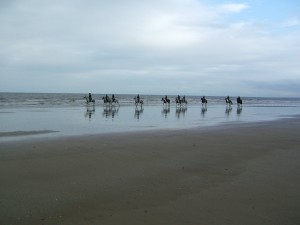
And then you add dogs – when the horses have gone, of course. Sea-going lurchers come in two varieties: alpha brain-boxes (eg. Chilli) who know what the sea is, and good-natured bumblers (eg. Django) who keep trying to drink it and then spit out salt. Do they swim, you ask? In fact can lurchers swim at all?

They usually don’t, but they usually can. They like water, when it’s doing what it’s told, and ours head for it without hesitation. Lurchers typically paddle, run and splash up to tummy level, whereas juggernauts like our old labrador plough straight in.
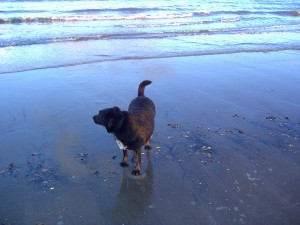
As a curious aside, Chilli has an incredible ability to find the wet stuff, which we’ve seen repeatedly. We were once on a long moors walk where Django became wobbly from the heat and had trouble going on. Our alpha wonder shot forward ahead of us, and in five minutes had found the only ditch/stream with water in it on the whole moor. A good dunking, and all was well. This is the very moment, in fact:

Every so often you do meet a swimming champion among lurchers, but we’ve never had one. Word on the street is that some saluki crosses have webbed feet (from all that swimming on sand as they pull down antelopes), and that they make good swimmers. But saluki crosses often don’t do what you ask them anyway, so you might never know.
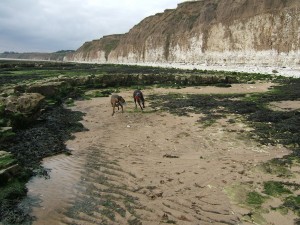
What longdogs do is charge. Those miles of sand (and a 40mph velocity) mean that the loyal companion by your feet is suddenly somewhere near the next county, a tiny dot which might be anything, frankly. You might be going red in the face and whistling for a seal which dropped its sunglasses the day before. We’re fortunate in that our two run in huge circles, which means that they do pass by every so often. “Oh look, there are the… no, they’ve gone again.”
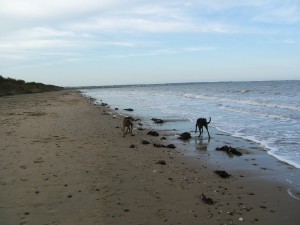
Chilli, who gets bored on the flat eventually, also delights in heading for rock-pools we can’t reach, or trying to climb the most dangerous, most crumbling bit of cliff she can find. Meanwhile, Django stands panting and drinks sea-water for the tenth time, having totally forgotten once more that he doesn’t like it.
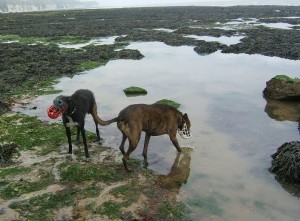
A day by the sea with longdogs is, basically, a joy. But take your own fresh water supply, especially if you have a Django.
####
Now, the next section is less lurchery. Before we interviewed nautical fantasy author Matt Willis a few weeks ago (see sea serpents, saltwater and ship’s biscuits), he mentioned coming across a talk given on William Hope Hodgson and maritime horror a couple of years ago. So we dug around for more details.
The paper in question was delivered by Dr Alexander Hay at the Sea Lines of Communication Conference Proceedings, Southampton, University of Southampton in 2014. The University said it was fine for us to use it, but could we link directly to the original paper held in their e-archives, so we’ve compromised. The paper covers Hope Hodgson’s nautical work and focusses especially on three pieces:
- The Voice in the Night
- The Ghost Pirates
- The Haunted Jarvee
What we offer below is the first part of Dr Hay’s presentation – the introduction and themes, and his commentary on The Voice in the Night. A link to the rest is provided at the end.
The Maritime Horror Fiction of William Hope Hodgson – Archetypes and Nuance
By Alexander Hay PhD
The Sea represents many things, but one recurring subject is horror. Whether it is Ulysses driven insane by the song of the sirens as he is lashed to the main mast of his ship; Umibouzu, the sinister giant black figure that haunted Japanese fishermen and sailors; Coleridge’s Rime of the Ancient Mariner, with its depictions of living death and doom; the shipwrecked mariners contemplating cannibalism and ‘otherness’ in The Narrative of Arthur Gordon Pym or Peter Benchley’s Jaws, the sea has long been both source and setting for horror.

In this year alone, we have seen Godzilla return to the big screen from the depths of the Pacific Ocean, leaving devastation, metaphors and tsunamis in his wake, and all the while Great Cthulhu continues to sleep in the mathematically impossible city of R’lyeh at the bottom of the sea, until the day he surfaces once and for all and brings us to our doom – perhaps with a loud BLOOP as he rises…
This then is what I term ‘Maritime Horror’ a sub-genre which both maligns and celebrates the sea as horror or backdrop to horror. As I have mentioned, maritime horror already has a substantial canon and this will no doubt continue to grow for the sea continues to fascinate and frighten us in equal measure. However, this paper’s aim is to make a case for the pre-eminence of one writer in particular, William Hope Hodgson.
There are many reasons why we should revive interest in this author. As a pioneer of cosmic horror, as his novel The House on the Borderlands demonstrates, Hodgson’s influence was admitted by HP Lovecraft himself and so, through him, modern horror owes a great debt. He was and is one of many writers and artists whose death in World War One threatens their total obscurity. Perhaps then, in the centenary of this war, we should renew our interest in both him and other authors whose lives and careers ended far too soon on the Western Front.
Yet what is most significant about Hodgson, beyond his having written a great deal of maritime horror fiction, was that he was himself a former mariner, first becoming a sailor at age 14 before becoming disillusioned with life at sea and starting a career as a physical trainer and then an author after his 25th birthday. Prior to this, he had formal training as an apprentice and then a third mate while also developing an interest in naval photography.
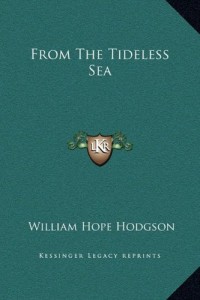
Nonetheless, his passion for the sea was dimmed considerably by what he described as “a comfortless, weariful, and thankless life” while he himself was a volatile, even at times unpleasant individual, who encountered mixed fortunes throughout his life. For Hodgson, conflating his experiences with horror and the foreboding unknown took very little effort. Yet I would argue that this also gives Hodgson an insight and authority in regards to his subject matter that other authors lacked – for he really did obey the maxim that you should write about what you know.
Hodgson wrote many examples of Maritime Horror and nautical fiction – over fifty – but given the scope of this paper, we will look at three as way of an introduction. The first example of this approach, combining the realism of first-hand experience with the uncanny, was The Voice in the Night, first published in 1907 and, coincidentally, used as the basis for the lurid, subliminally sexual Japanese castaway horror film Matango in 1963. (Like Godzilla, a production by the Toho studios, who also made Ringu in 1998, yet another horror film with nautical roots.)
Here a mariner recounts how his ship, “becalmed in the Northern Pacific” was approached in the middle of the night by a strange figure in a rowing boat. The stranger refuses to be seen and instead pleads for food while, ominously, wishing to keep his distance from the narrator’s boat. Eventually, the ship sends food over to the rowing boat via a boathook and a float, and the stranger then recounts his tale.
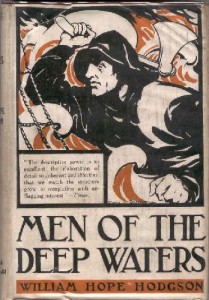
It transpires that he and his fiancée were shipwrecked on a strange island riddled with fungus which infects and then eventually takes over its hosts. It has an unusual allure that compels its victims to eat or desire it, much like the fate that befalls the lotophagi in The Odyssey, victims of another corrupting force, spiritual as well as physical, and also encountered on an island in a seafaring narrative. The fiancée eats some of the fungus and becomes infected while the stranger is contaminated while fighting off what is left of another host, which tries to attack him.
Realising they are infected, they decide to quarantine themselves, eating only whatever untainted food they can find. It is implied that the infection has nonetheless almost completely consumed the fiancée and that the stranger is trying to keep what remains of her alive until such time that he too completely succumbs. Finally, the narrator catches a glimpse of the stranger rowing away in the early dawn light and is horrified to see his deformed fungoid form. No longer able to empathise with the stranger – a final tragedy and horror in the story – the narrator refers to him instead as “…the thing” as he heads towards his inevitable doom.
Here Hodgson combines three separate strands. On the one hand, he dwells upon body horror and the corruption of the flesh. This is a disruptive, invasive force not just on the body but on social norms of the day – the fiancée, expected by contemporary convention to remain chaste and pure, is the first to give into a depraved appetite for the fungus and is subsequently made to “promise on her knees” never to do it again, she herself admitting that “the desire for it had come suddenly, and that, until the moment of desire, she had experienced nothing towards it but the most extreme repulsion.”
This conservative narrative of fallen woman laid low by lust (whether it be for fungus or other more primal desires) is subverted, however, by the stranger’s own subsequent downfall, where he is “immediately filled with an inhuman desire. I turned and seized a mass of the fungus. Then more and — more. I was insatiable.”
Hodgson also alludes to the maritime connections between the sea and leprosy – like the fungus, a contagious disease which corrupts and rots the flesh. It is worth noting that six years before The Voice in the Night was published, the United States government founded a leprosarium on the island of Culion, where all lepers were to be quarantined and isolated. The sea, in fact, was a common way of separating society from the leprous ‘other’, the 1866 founding of the Moloka’i leper colony near Hawaii – still very much in use by 1907 – being yet another real life example of the Pacific ocean used to create a separation between the uninfected and the leprous, as well as the natives of the islands and the new ruling class of white settlers.
This in turn harked back to even older traditions, such as the ritualised sequestration of lepers during the Middle Ages, and where a common literary device was to have a sinful or impious character afflicted with leprosy as both punishment and means of salvation through the acceptance of divine authority. It is worth noting here that the stranger mentions God on a regular basis, either calling upon him to reward the narrator and his ship for its charity, or throwing himself and his fiancée onto the mercy of the divine – “God would do with us what was His will”, as the stranger says, perhaps with added poignancy given the plight that befalls both him and his fiancée.
The third strand, however, is the nautical element of the story. The stranger and his fiancée were abandoned on their demasted ship (the ominously named ‘Albatross’) by the crew and were forced to make an improvised raft which carries them not to salvation but their doom. It is implied that their lack of knowledge of the sea is partly the cause of their plight, though this is subverted at the end of the story by the narrator noting that the stranger was now almost indistinguishable from his grey rowing boat – “my eyes searched a moment vainly for the conjunction of hand and oar.”
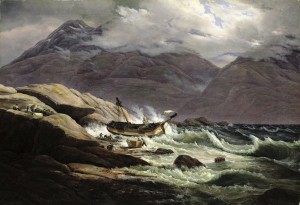
By the end of the story, the stranger had, ironically, begun to learn the skills that he lacked at the start of the story, though this was now far too late for either him or his fiancée. Hodgson also implies that the original sin is not the couple giving into the ‘forbidden fruit’ of the fungus but their crew abandoning them and the duty of mariners to support one another in what is, after all, an environment that requires collaboration. Again, it is only belatedly that this duty is fulfilled by the narrator’s own ship, and it is too late. Here, we see the conventions and structures of seafaring life decayed and corrupted, like the bodies of the couple.
Instead, the stranger is transformed by his exposure to the sea, like a sailor, but is also undone by it, and doomed to become part of its dark mythology, something that emerges from its outer reaches and serves as a reminder of humanity’s inability to master it and, ultimately, nature. In many ways, then, The Voice in the Night is a nautical ghost story, with the added horror of the stranger being not quite dead yet – nor quite anything else.
And for Hope Hodgson enthusiasts, you can find the rest of this piece at:
http://eprints.soton.ac.uk/369928/
####
Right, we’re done for now. One of our Weird Art posts in a day or so, with that incredibly talented German artist Michael Hutter, so come back soon…
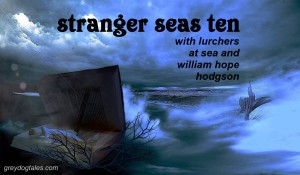


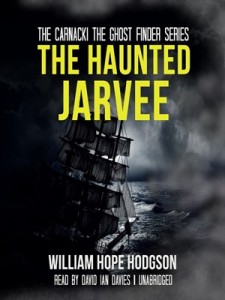

Sea horrors, sea shores, and wet hounds…what is not to like?
We thank you from the bottom of our muddy little hearts. Now waiting to take another run along the shore when the weather improves.